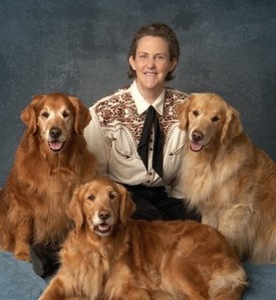
Temple Grandin is a best-selling author and a professor at Colorado State University. Self described as a highly-functioning autistic with a PhD in animal science, she’s worked closely with the fast food industry to develop humane slaughtering practices. Grandin is credited with dramatically impacting animal welfare, particularly livestock, for the better. Her life is the subject of a 2010 HBO film starring Claire Danes.
DT: Your often describe your thought process as different from the way non-autistic people think. In fact, your first book was titled “Thinking in Pictures” – can you explain what that means?
TG: My mind is totally visual. When I think about something, it’s sort of like I’m searching Google for images. If somebody asks me a question about an animal behavior problem, I actually see the dog. I have to ask what breed it is so I can see it. I can run a full motion video in my head if the person can give me enough information. And then words narrate the videos in my head. I’m looking at videos in my head as I talk about things.
DT: One of the reasons you feel such a kinship with animals is that you believe their minds work similarly to the way yours does, right?
TG: If you study neuroscience, there’s no other way that an animal could think because the brain is set up to store memory files as visual images, sounds, audio clips, smells, touch sensations. It’s sensory based, not language based.
DT: This is important because once people understand how animals think, it’s less of a leap to recognize that they do have emotions.
TG: Animals definitely have emotions. If you look at the way mammals’ brain circuits are made, they have the same circuits we have. The main difference between a dog’s emotions and our emotions is ours are much more complex.
You see, the animal mind sets up file folders. That’s why a dog might have a different set of behaviors for off the leash vs. on the leash. Off the leash is a different picture than on the leash. They’re two different categories.
DT: You’re saying that animals’ brains work like a computer?
TG: Well, human brains work like a computer too. The difference is, some functions are covered up by our more abstract language.
DT: Is it good to be a dog these days or do you still see issues with the way Americans treat their animals?
TG: I’m very very concerned about separation anxiety in dogs. In my town, Ft. Collins, Colorado, you get a seventy-five dollar ticket if your dog is off leash. So to give your dog a proper social life, you’ve got to really work at. Back in the 50s dogs just ran around loose. They had a social life. The downside is that they got hit by cars. But they had a much better quality of life.
Nowadays there are too many dogs locked up all day, whining, chewing up their paws. That’s not a very good life for a dog. So you gotta do something about it. Give them another dog to play with, take them to work if they’ll allow it, take them to doggie daycare. But a dog doesn’t have a very good life if he’s locked up in a crate for hours and hours on end.
DT: What about a dog walker that comes in once a day?
TG: Well, animals are individuals. Let’s get back to the core emotions: How strong an animal is in each of these is somewhat genetically controlled. Some dogs are highly needy. There are going to be some dogs where bringing in a dog walker once a day is not enough, other dogs may just sleep and be ok the rest of the day.
DT: Thanks, Temple. It was an honor to speak with you.









